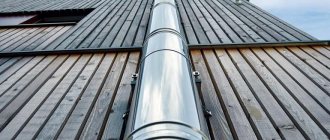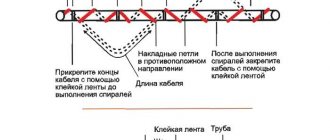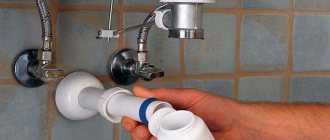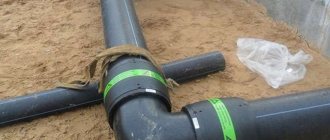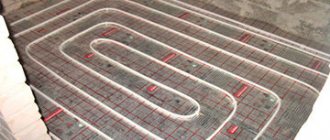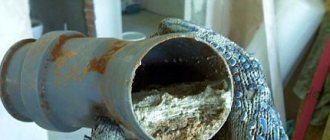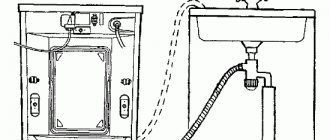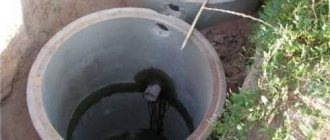A siphon for a kitchen sink is an important element of plumbing equipment, because water is drained through it. Thanks to this device, there is no sewer smell in the room and no pipes become clogged, because all food debris is collected in its lower part. However, to avoid problems with such equipment, proper installation will be required. Today we will look at the principles of selecting and installing siphons.
Siphon for kitchen sink
What is a siphon for?
From time to time, any kitchen plumbing requires repair, but not all users know the names of the components, including the pipe under the sink. A siphon is an element without which the sewer pipe will constantly become clogged, and characteristic odors will appear in the kitchen.
Double siphon with filter
The main advantages of installing a drain element should be highlighted:
- high strength;
- shock resistance;
- simplicity of the device;
- no installation difficulties.
The special design allows you to remove blockages without the help of a professional. In addition, such products are resistant to high temperatures.
A siphon intended for kitchen sinks is complemented by a small piece of pipe to which the drain is fixed.
If the design of the plumbing requires two drains, then install a double siphon. The device requires an additional pipe and adapters to connect the holes.
Sometimes it is allowed to use systems for a kitchen sink that are intended for showers and bathtubs. In the first case, the drain will be flattened, which allows you to leave more free space under the sink. The second option involves the presence of an additional overflow. This design allows you to avoid flooding the kitchen with water when the sink is filled to the brim. Once the water enters the overflow, it goes down the drain.
A siphon designed for a washbasin can also be used for a kitchen sink. In appearance, it is compact and has a curved pipe, so it will save space.
Design option with additional overflow
A drain that is installed in a toilet is absolutely not suitable for the kitchen. Despite the fact that it is also fixed inside the device and acts as a water seal, which prevents the spread of odors.
Find out which kitchen faucet is better to choose, high or low, in a special article on our portal.
Prices for siphons for sinks with overflow
Sink siphon
Advantages and disadvantages of different types of corrugated siphons
Corrugation. This is a flexible folded pipe made of plastic, less often metal, with connecting elements and a hole for draining water from a sink or other plumbing fixtures. A water seal in such a siphon is formed because the pipe is bent during installation (that is, it forms an “elbow”) and secured with plastic clamps.
The advantages of this design include:
- low price;
- mobility - if the sink is moved, the corrugated drainage device can be easily moved due to its ability to shrink and stretch;
- compactness;
- versatility - the corrugation is suitable for almost any plumbing fixture (sink, bath, shower, bidet), in addition, there are models with several outlets for connecting to household appliances);
- ease of installation - assembling and installing a corrugated siphon can be done easily without the help of a specialist.
But this device also has its drawbacks. These include the low strength of the pipe (it is easy to damage mechanically), as well as the ability to accumulate fat and small waste in folds. Therefore, the corrugated siphon needs periodic cleaning, which consists not only of using special chemical compounds, but also of washing it with running water when dismantled.
Do not forget that you cannot crush the pipe or use sharp objects on it, as this will lead to the appearance of cracks and, accordingly, leaks.
The corrugated metal siphon looks stylish and aesthetically pleasing; due to its rigidity, it does not need to be fixed with clamps, which is why it is used for open washbasins.
Corrugation is also used in bottle siphons, where it replaces a standard rigid pipe and makes it easier to connect the device to the sewer. This corrugation has the advantages of both types of siphons. In addition, if there is a flask, the device is easy to clean, due to which its corrugated part will not need frequent washing.
How the drain works
A standard siphon is a curved pipe with different elbow lengths. It turns out that the liquid from the bowl located above flows into the container located below. The water level is important for the functionality of this device, so it is pre-filled.
Thus, water is constantly located in the curved part of the device. Thanks to its characteristic shape, pressure is maintained there all the time, the drains are renewed, which prevents the spread of odors throughout the kitchen. Waste liquid goes down the drain every time it is used.
For example, liquid flows from a bowl into the outlet. Then it is poured into the bottle, and then into the branch connections. The wastewater is then sent to the outlet compartment and into the sewer pipe.
The principle of the siphon
The drain has the following design:
- body part, which can be disassembled if desired;
- lower outlet pipe;
- protective mesh with cells with a diameter of about 10 millimeters;
- connection screw for the mesh and pipe;
- a tube for discharging wastewater into the sewer;
- gaskets that are fixed between the body part and the pipe;
- plastic fasteners.
Principles for connecting a drain system in the presence of a sink with two bowls
Varieties
The domestic market offers a large segment of plumbing products. The products are represented by chrome-plated, metal and plastic devices for high-quality drainage. All units can be equipped with automatic and semi-automatic systems for shutting off and supplying water. They are divided into three types.
Traditional
Standard drainage design with ordinary rubberized or plastic plugs. All spillway processes are carried out manually, however, such designs have the following advantages:
- Reliability;
- Ease of operation;
- Durability;
- Undemanding to service.
Semi-automatic
Such a spillway is controlled using levers or cables, which are installed at points located above the level of the collected water. This design of a siphon for a sink has its advantages in the form of:
- Control using a remote crane;
- Plug built into the drain hole.
Auto
Plumbing spillway equipped with automation. Such a siphon is combined into a single structure with a filling device. Control here occurs thanks to a special valve that releases excess liquid into the drain hole when overloaded. These are modernized siphon devices that bring complete pleasure to the owners of the house during their operation. However, they have one drawback, which is their rather high cost.
The most popular automatic spillways are those that have the following functions:
- "Click-clack";
- Rotary handle.
Characteristics of siphons
Siphon dimensions
If the dimensions of the drain do not correspond to the diameter of the sewer pipe, then installation will be problematic. In addition, the throughput of the device is important. Another important thing is the length of the interval between the exit to the sewer and the siphon.
According to the standard, the device has a length of 75 centimeters . Usually, a piece of pipe is enough to connect it, but various situations arise, so it becomes necessary to purchase adapters. They are still needed when the exit to the sewer is not opposite the drain.
Connection diagrams with dimensions
The entrance to the sewer under the washbasin is most often mounted at a height of about fifty centimeters. The diameter of the inlet pipe varies from 30 to 92 millimeters , so the pipe must be suitable in size or be thinner. If the diameter does not match, then all that remains is to install an adapter.
The need to purchase an adapter also arises in cases where the sink has an unusual design. For example, this applies to products with a pedestal. Under such circumstances, the compact drain will not be visible inside.
What materials are siphons made from?
Initially, such structures were made only from cast iron, but over time, more compact products made from non-ferrous metals appeared (even today such siphon options remain in demand). Devices with galvanic coating are considered reliable, because they are not afraid of even corrosion. However, experienced craftsmen do not recommend purchasing such siphons, because when installed internally, they quickly oxidize and fail.
Steel products are considered the most durable and durable. However, their main disadvantage is their high cost, which is why they are most often installed on expensive plumbing fixtures. If you want to save money, then purchase plastic structures.
Metal siphon with galvanic coating
Plastic products are most often made from polyethylene or more expensive polypropylene. Compared to metal siphons they have a number of advantages :
- minimal weight, which will reduce the load on the sink;
- Fatty plugs are much less likely to collect on plastic;
- the material does not rot or rust;
- products are characterized by long-term operation;
- low cost.
The main disadvantage of plastic siphons is the possibility of their destruction under the influence of temperature changes. This happens especially often at joints.
Siphon made of plastic
Types of siphons
The drain must necessarily correspond to its intended purpose, therefore, in addition to the material, the design feature should also be taken into account. So, we will look at various options for siphons that are installed on the kitchen sink.
Table 1. Popular types of siphons.
| View, illustration | Description |
| Corrugated | This is the most primitive design, which is a type of curved pipe with folds. Thanks to the elastic frame, you can attach such a siphon in any sink. One of the disadvantages of corrugation is the accumulation of a large amount of debris inside. In addition, the pipe may become deformed due to boiling water. |
| Pipe | It is a solid pipe with bends. On sale you can find both collapsible and non-collapsible options. Installation in this case is complicated by the fact that the drain must be installed exactly in the direction of the sewer hole. |
| Bottle | This is one of the most popular designs. The water seal is located at the bottom, so the siphon can be quickly cleaned of dirt. |
Note! Branched models of siphons allow you to cope with complex installations when you need to connect several washbasins. In addition, they are convenient when you also need to connect a dishwasher and washing machine.
Siphon operating principle
Classification by material
Until recently, siphons for kitchens and bathrooms were made only from cast iron and brass. However, time does not stand still, and so does technology. Modern siphons are made of stabilized polypropylene, PE-RT polyethylene and high-quality metal.
Metal
Chrome-plated metal water seals harmonize perfectly with such elements. Therefore, a fairly good option would be to install them in bathrooms. And expensive samples of metal units will look simply luxurious. It goes without saying that the price of such devices will be much higher than their polymer “counterparts”. However, their service life will differ much more.
High-quality alloys are used as the basis for the manufacture of metal siphons:
- Copper;
- Brass;
- Bronze;
- Of stainless steel.
Such spillways are not susceptible to corrosive deformation, but are subject to redox reactions. Therefore, a good-quality metal elbow under a sink must have internal galvanic chrome plating. Such a coating will also serve as a barrier to the appearance of dirt and clogging in the water seal.
A small disadvantage of a metal spillway is the difficulty in adjusting the pipe to the required size. After all, such manipulation requires a professional tool and experience in using it.
Plastic
The most popular units among consumers are spillway units. Presented in the form of polymer connecting pipe elements. It is quite easy to install such a siphon in the kitchen or bathroom yourself. Due to its quality properties, this siphon has a number of advantages in the form of:
- Resistance to corrosive destruction and deformation;
- Resistant to decay;
- Resistance to negative chemical influences;
- Easy to assemble even for a beginner;
- No formation of limestone deposits on the tubes;
- Small overall dimensions;
- Installation in the most inaccessible locations.
Siphon manufacturers
You can find products on sale from various manufacturers, all of which have certain advantages. In order to better understand this issue, we will consider the most popular brands.
Table 2. Popular manufacturers of siphons and other plumbing components.
| Name | Characteristic |
| "Viega" | This is a German company that produces both expensive and budget products. Along with high quality, their designs are easy to install, thanks to the latest technologies. |
| "Geberite" | This is a Swiss manufacturer that produces various devices for sewerage and plumbing. The structures are not only durable, but also attractive in shape. |
| "Blanco" | Another German company that is distinguished by its wide range. Thus, buyers have the opportunity to purchase products not only of different shapes, but also from all kinds of materials. |
| "Virken" | A French company that also produces components for plumbing fixtures. Their factories are located in various countries around the world. The main features of this brand are reliability and high quality. |
| "Santek" | A domestic manufacturer that produces high-quality plumbing elements made of plastic. A distinctive feature of this brand is the availability of a product warranty of up to ten years. |
| "Jimten" | An Italian manufacturer that produces high-quality components, including siphons. |
| "Vir-Plast" | A domestic company whose distinctive feature is the production of budget products. However, all products undergo mandatory certification and therefore meet quality standards. |
Imported siphons
Note! If you have a limited budget, then it is recommended to opt for Russian-made models. Contrary to some opinions, they are not inferior in reliability and quality to any imported siphons.
What to look for when choosing
Given the current criteria for choosing the required siphon, you first need to take into account:
- Matching the calibration of the sink, washbasin and pipe.
- The metric characteristic of the maximum amount of liquid into the channel must be increased when connecting secondary plumbing units. In this case, the number of sewer outlets must be increased.
- Matches with available space. With a tiny square footage, you should choose a compact corrugated spillway.
- The selection of a water seal should be in accordance with the design of the sink.
- Carefully check the device for nicks and defective punctures.
When purchasing a siphon, special attention should be paid to its design. Photos of chrome, metal and polymer samples of spillways can be viewed on the pages of Moscow online stores. You can buy a high-quality product at the manufacturer’s price and significantly save your effort and money, without even leaving your home.
Recommendations for choosing a siphon
In order to make the right choice, you need to listen to the following recommendations:
- You should not buy a siphon and its accessories separately, because they may not be suitable for some parameters. Experienced craftsmen advise purchasing a whole set .
- You need to think in advance which model will best fit into the design of your sink . For example, if there is minimal space left under the sink, then it is advisable to buy a miniature siphon.
- Even simple models can be modified thanks to special devices. To do this, purchase plugs, various gaskets, plugs, which will be useful when installing a branched system.
- be handled with care during installation , as there is a risk of damaging (bending) them. This will cause debris to begin to accumulate in the pipe.
- If the installation involves a closed arrangement of the siphon, then you should not spend extra money on designer products, so the main thing here is to take into account quality .
Only when the bottom of the sink is open does it make sense to choose decorative designs
- As a rule, the siphon kit comes with instructions for its assembly , which must be studied before installation.
It is recommended to choose durable products from reliable manufacturers
Selecting the right model suitable model
The choice of a corrugated siphon for a sink is determined by several main factors:
- the place where the siphon will be installed;
- the size of the sink and the diameter of the drain hole;
- the material from which it is made.
If the kitchen sink is located in a place where there is very little space under it, definitely just install a corrugated pipe and bend it. If space allows, you can also use a glass siphon with a corrugated outlet. The choice of material and the money for which the buyer is willing to buy the product are interconnected. If strength and durability are more important, it is better to choose metal corrugation. If the budget is limited, the plastic corrugation for the siphon will cope with its functions, but it will have to be used more carefully.
Subtleties of installing a siphon under the sink
If you have not changed your plumbing fixtures and components for many years, then the best solution would be to completely replace the drain. As we have already said, the best option would be to purchase a plastic product.
It is worth noting that replacing the siphon does not require any special skills. In order to understand the problem, we will look at the process in more detail.
Modern devices require the ability to quickly dismantle and install them yourself
Removing the old drain
Before attaching the new device, you will need to dismantle the old one. To do this, use a screwdriver to unscrew the fastening element, which is located in the central part of the grille. Thanks to such manipulations, the old siphon can be quickly removed. If the parts are stuck to each other, you can use acetone.
Removing the old drain
Assembling a new siphon - step-by-step instructions
Before you begin assembling the structure, you need to lay out the kit parts on the table to check their quantity, this applies to gaskets and pipes.
We will consider an example of an assembly based on a leak from .
Siphon disassembled
Step 1. The first step is to connect the parts of the flask, so first we fix the thin gasket.
It should be pressed evenly on each side
Step 2. Now you should attach the lid to the bottom of the structure.
It should stick without using silicone sealant.
Step 3: Attach a nut to the corrugated pipe.
The part is included with the siphon
Step 4. The next step is to attach a cone-shaped gasket to the pipe, which is needed for tightness.
The sharp part of the gasket should be located towards the outlet
Step 5. The drain must be secured to this gasket.
It is necessary to tighten the nut tightly to ensure a sealed structure.
Step 6. Another nut and gasket are secured to the bottom of the pipe.
The gasket is fixed last
Step 7. Now the lower part needs to be secured to the drain.
The nut is pressed tightly
Once the assembly is complete, all that remains is to secure the structure under the sink.
Prices for kitchen sinks
Kitchen sink
Video - Assembling a sink drain
Features of installing a drain with overflow
Information about drain collection is included in the instructions that came with the siphon. To work you will need:
- flat screwdriver;
- insulating tape;
- siphon;
- bucket;
- sealant;
- adjustable wrench;
- a napkin made of paper or fabric.
When choosing a sealant, preference is given to products based on rubber or silicone. The products must be suitable for connecting plumbing parts.
System assembly
First, connect the drain to the sink. The structure is placed under it and the dimensions are first checked for compliance. Next, unscrew the plug from the bottom of the device and inspect it for damage, thereby checking the reliability of the structure.
Before assembly, inspect the threads on the body. If there are burrs on it, they are carefully cut off. If this deficiency is not corrected, damage to the O-ring may occur during installation. Before installation, check all threaded connections, nuts, joints and gaskets.
To assemble the device flask, you will need:
Siphon assembly process
- put the gasket on the threads of the upper section of the structure;
- screw the bottom of the siphon;
- place a rubber seal of the appropriate diameter on the drain tube and put on 2 tension nuts;
- insert the drain pipe into the hole at the bottom of the siphon, push it to the desired height and tighten the nut loosely;
- install a gasket in the cover of the device and screw the drain to the body.
The rubber seal placed in the groove is coated with a small amount of sealant. To ensure reliability, the substance is lubricated with the lower thread of the plug, which is screwed into the body. To tightly connect the parts, a winding is used to remove the element when necessary. Before collection, the length of the tube is selected, the height of which is determined by the depth of the shell.
The main pipe is connected to a tube with clamps. Subsequently, the part is mounted to the sink, placing a gasket between the elements. The area between the pipe and the overflow with outlet is secured with a nut. It is recommended to tighten plastic parts by hand to avoid breakage.
Installation of the structure
First you need to turn off the water, connect the protective grille and the sink drain hole, placing a rubber seal no more than 5 mm thick between them. If the grille dimensions are larger than the hole, use a sealant rather than a gasket. A rubber seal is placed on one edge of the outlet pipe, and a chamfer is removed from the other edge, improving the fit of the pipe into the siphon.
To connect the sink and the pipe, you will need a screw with a diameter of 6 mm. The part is inserted into the protective grille and tightened. Then the drainage pipe is connected to the outlet pipe. In this case, it is necessary to monitor the connection points. For reliable sealing, you can use plumbing tape.
Installation diagram of a siphon to a two-section sink
The assembled siphon must be connected to the outlet pipe, which was previously connected to the drain. After this, a connection is made between the sewer and the drain. Before installing the cuff into the pipe, a layer of sealant is applied to it and the outlet end of the outlet pipe is placed in the part. For connection, a rigid assembly is used, connecting the sewer outlet and the pipe with a conical gasket and a nut.
If corrugated hose is used, the length of the soft hose should be such that it does not sag during use. If the dimensions of the outlet and the sewer pipe do not match, a plastic adapter will be required. You can prevent smell from entering your apartment by using a rubber cuff, which is placed in the socket.
Materials and accessories for installation
In order to install the drain, you will need a screwdriver, a measuring tape, and fine-grained sandpaper . In addition, special scissors . Before starting work, you should stock up on silicone sealant, plastic adapters, and FUM tape .
Siphon installation process
The assembled drain installation has a certain sequence:
- An O-ring is placed on the pipe section , and another is installed under the grate.
- The structure is placed on the sink, and a grate is fixed .
- The screw fastening is tightened.
After which the outlet hole is mounted in the drain. As we have already said, if the pipe does not fit the drain, you will need to attach an additional adapter.
A wrench is used during installation
After installation is complete, you need to make sure the drain is working. To do this, fill it with liquid and check the shutter level .
Video - Installation of a drain on a sink
How to hide?
You can’t do without a siphon, but in some places, for example, on a bathroom sink, it doesn’t always look pretty. Sometimes its appearance can ruin the entire interior. Avoiding this is completely easy. Many people don’t even try to hide modern siphons, making them part of the interior of the kitchen or bathroom. Of course, if you purchase a stainless steel siphon, it can become a decoration in itself.
However, most models still need to be covered with something decorative. The simplest option is a special sink leg, which can be purchased separately. You can match it to the existing plumbing fixtures or, conversely, take something that stands out. With such a leg it is very easy to hide both the siphon and partially the pipe leading to the sewer. Another fairly simple and effective way to keep all the unsightly things behind and under the sink is with a cabinet. It can be easily installed under the sink. Its simple design will reliably hide everything unnecessary. Such modifications can be purchased ready-made in the store or made independently. For such a cabinet you will need drywall, profiles, some tools and some free time.
If you want, you can cover the pipes and siphon with a plasterboard frame, and then decorate it with tiles. This will allow you not to leave any unnecessary gaps and all unattractive moments will be reliably hidden from view. Of course, for a bath, where the humidity is often very high, you can choose materials that are more resistant to moisture (glass magnesite).
The most important thing is that when covering the place where the siphon is installed, you need to make sure that air flows there, so it is better to leave small gaps on the sides or bottom.
How to care for your siphon
Any plumbing fixtures and their elements require subsequent care - careful handling of the drain will extend its service life. First of all, you should not allow blockages to accumulate in the pipes . chopping device under the grate will help correct the situation . However, even this will not solve the problem forever.
It is necessary to periodically check the functionality of the siphon
The cleaning method will vary depending on the type of drain. Thus, the corrugated pipe is cleaned only after dismantling. The bottle model can be cleaned with a special cable .
Pipe cleaner
Note! During the cleaning process, various acid-based chemicals However, they should be used with caution - some of them contribute to the destruction of plastic. Before purchasing chemicals, you should carefully study the instructions on the back of the package.
Prices for cleaning clogs in the kitchen
Products for cleaning clogs in the kitchen
Peculiarities
The widespread use of corrugated connecting structures is due to the fact that they are much stronger than pipes with a smooth surface and are convenient to use. Due to the ability to stretch and compress, it is not necessary to use additional fasteners. Corrugation is a flexible ribbed pipe that is available in single-layer and multi-layer types. It can be ribbed on the outside and smooth on the inside.
According to their intended purpose, they perform connecting functions for transporting waste liquids to the sewer system. When used in sewer drains, they actually play the role of water seals, which, based on physical laws, ensure, along with drainage, the creation of an air gap in a pipe curved in the shape of the letters U or S and, accordingly, protect the room from unpleasant odors.
Let's sum it up
Shower cabin with a steam generator, if you have not yet heard about this newfangled option for the bathroom, we recommend that you familiarize yourself with the details about the operating principles and installation tips in our separate article.
In order to purchase a high-quality siphon, you do not always have to spend large sums - now you can find many domestic and imported models at an affordable price. In addition, their device allows installation without the help of a specialist. You just need to carefully follow all the steps of the instructions, without missing out on the details.
What is overflow
An overflow is an additional tube that is removed from the sink and connected to part of the siphon or its pipe. It prevents water from overflowing over the edge of the sink. The water, having reached the second hole in the sink, located close to its edge, begins to calmly flow down the overflow into the sewer. Thus, flooding of an apartment with such a design is unlikely. Accordingly, recently the demand for such a model is significantly higher than for siphons without overflow.
